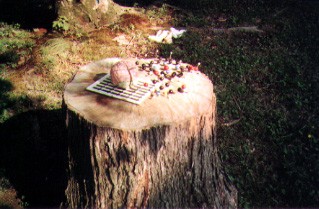|
PART 6: Plato’s Allegory of the Cave, the Transcendence of the human brain and what’s left of “the urge to love” |
||||
|
Section 1: Plato’s Allegory of the Cave and Conceptions of Reality |
||||
| One of my favorite stories which was taught over and over again in my philosophy classes is Plato’s Allegory of the Cave. It actuallysets a context in which to evaluate everything we been talking about so far. | ||||
| In a cave there are all these people who are chained by the “puppet handlers” who hold them captive. However, the prisoners’ do no know they are there. In fact, they do not know that they are captive at all. The prisoner’s can only see the shadows of the objects and of themselves…only the freed man has access to that from which the shadows come from. This man has escaped the cave and has assess to “reality”: | ||||
|
||||
|
Another
Another
Platonic idea, which is reflected in Allegory of the Cave, is his conception
of the WORLD OF FORMS. Plato introduced a kind of a dichotomy in his work.
He divided the universe into the sensible world, which we know through
the senses, and the intelligible world, which
we can know through the intellect. The things we come to know through
the intellect are these Forms. According to Plato these perfect concept
exist eternally.
The things in the sensible world, which we can only come to know through
our senses, are imperfect reflections of the ideal forms. |
||||
| So what’s wrong with this picture? | ||||
| Look outside the window, what do you see? Reality as Plato conceived of? | ||||
|
||||
| The way
we see “the world” is solely based on the type of machinery we are made
of … and that is in the brain! So Plato’s forms are also human conceptions
which exist in the brain. |
||||
| Now,
think back to the affects of damaged brain systems…how does the autistic
person see the world? As one in which interpersonal relations no longer
makes him “feel good.”So am I
talking
materialism
in a sense that all there is is the physical world of the brain and
“nothing else”? What about Kramer hypothesis? …how does this fit in the
larger context of interpersonal relations? |
||||


